The modern hospitality industry represents global on the scales the complete, integrated and dynamic branch of the services sector which is entirely based on the principles of market economy, objective regularities of the international division of labor and production internationalization. Growth of the hotel economy was outlined in the Republic of Kazakhstan only with town planning development after its joining to Russia. After October revolution by development of production and non-productive spheres construction of hotels approached to their modern shape in Karaganda and Almaty the majority from which functioned in the conditions of planned managing began. In this article is used the method of the ABC analysis for more exact consideration of a condition of the hotels services market in present conditions of economic development of the Republic of Kazakhstan.
Management of the hotel enterprise demands developed multi — abilities of work and flexibility, to be able to switch immediately mechanisms of customer service, management of staff, marketing and organization of events. The main objective of administrative decisions — to be sure of safe, satisfactory stay of guests in hotel. For effective management of hotel business it is important to consider the following:
First of all, competence of the personnel and accurate distribution, knowledge of the management that is a task of each department and the employee — such approach allows effective control only from the management, and also increases the employee's responsibility, his «belonging» to the company; the worker feels powerful part of successful development of the enterprise. It is important to know the number of room cleaning, how the reception works to be aware of the complaints, and what quantity from them is processed by staff, to own information of all levels of management. In addition, to study problems and tasks of the service managers, cooks in daily work of the hotel enterprise. Possessing these qualities, there is on the one hand the practical knowledge, allowing considering and solving difficulties and complaints of employees in the long term, and on the other hand the authority of the management amplifies, owning skills and knowledge to build priority of the tasks arising at the same time.
Secondly, delegation is a key element of daily management of hotel. The chief manager watches all departments, however instead of him, staff reports about difficulties to the head of department. The decision are short daily meetings with chiefs of departments for example to remind of full filling of rooms therefore work of maids has to be executed as soon as possible, remind the cook of a large dinner in connection with carrying out conference. If the service manager directs repair in a hotel room, it is necessary to inform maids on it, thus, the last wait while repair will end. Thus it isn't necessary to burden chiefs of departments with excessive and unnecessary meetings for check of level of their professionalism or to learn how affairs proceed.
The more the management interacts with staff even if they don't report about the events, the more they feel responsible for good-quality work.
Thirdly, timely delivery of premium. Due to the broad working activity, there are no chances in single management of the hotel. In this case the delusion is incorrect that the majority of the personnel is considered so-called «a blue collar», not demanding systematic professional education, from this it follows that existence even the smallest program of training or professional development increases efficiency of processes of the hotel. However quite often to such personnel the minimum amount of work is paid that in itself contradicts the importance of performed work: purity of numbers, knowledge of procedures and service opportunities, politeness, courtesy and friendliness with guests, even in stressful situations. Fact in evidence is that systematic money bonus, and most often unexpected, motivate employees as anything other. Regularly it is worth allocating and encouraging leaders on performance of any tasks in each department, to improve system of motivation of employees for stimulation of working capacity of staff.
Fourthly, to carry out market planning. It is known that fillability of hotel depends on such factors as seasonality, events of regional, republican and international scales, economic development of the region and the country, climatic appeal, etc. Market planning in the hospitality industry allows free production of a certain quantity of goods and services long and the short-term period of time. Thus, the hotel management can make offers during a winter season of rest in the summer, in the winter to make the plan of summer actions, such as weddings, family rest, also to carry out planning for the autumn period — holding of conferences, forums, etc., considering the festive period of the region and the country [1].
Development of the hotel enterprises in some regions, certainly, has two explanations — natural appeal, economic appeal. The index of an indicator of number of the served visitors in hotels by areas is presented in table 1[2].
Placement in the hotel enterprises in 2012.
T a b l e 1
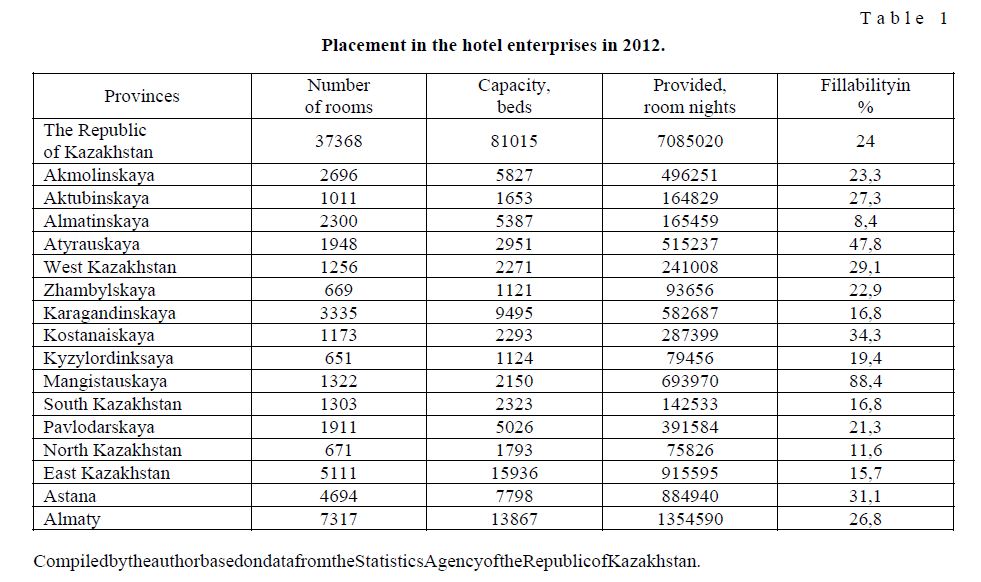
CompiledbytheauthorbasedondatafromtheStatisticsAgencyoftheRepublicofKazakhstan.
In 2012 in the Republic of Kazakhstan there were more than 37 thousand hotel rooms, with a capacity of 81015 beds from which more than 7 million room-nights were provided, thus, fillability of the hotel enterprises in the country was made for 24 %. For more detailed analysis of a current state of the hotel enterprises management, will use the analysis and creation of the ABC curve which results are shown in table 2.
Results of ABC analysis of quantity of hotel rooms in the Republic of Kazakhstan in 2012
T a b l e 2
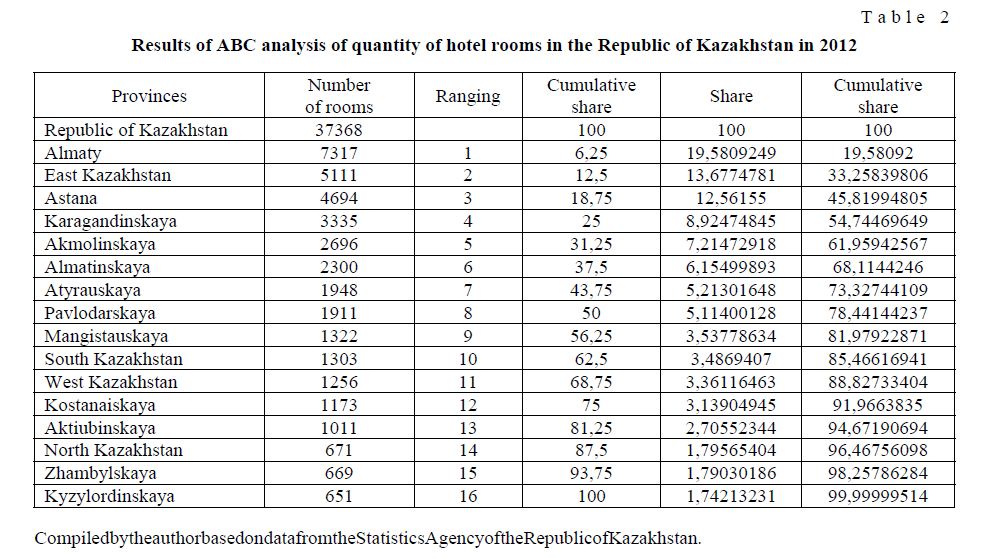
CompiledbytheauthorbasedondatafromtheStatisticsAgencyoftheRepublicofKazakhstan.
The ABC analysis is used for classification of resources of the companies, and also their ranging for the adjusted and effective management functioning. As a result of the analysis curve ABC according to which, it is possible to note positions is under construction and to designate the leaders making a considerable share in production of goods and services. According to Pareto's hypothesis and ABC analysis — 20 % of goods give the companies of 80 % of all turn. In this case there is an opportunity to range the cities and the areas making the «main» 20 % for the hotel industry in the Republic of Kazakhstan on available indicators [3].
For a start it is necessary to count number of elements, then there is a cumulative share of each of them in total amount of elements by division on proportions each element on 6,25 (100/16). After was the share borrowing with two, three, etc. with elements is calculated. Further we executed ranging of the cities and areas by number of rooms in the country from maximum to their minimum value then the percentage share of regions in the Republic of Kazakhstan was counted. Let's notice that the 1st place by number of numbers in the country is taken by Almaty, 2nd belongs to the East Kazakhstan region; Astana takes the 3rd place, and the last Kazylordinskaya area. Further there is a cumulative share of each of regions in total amount of numbers (the last column in table 2) which is a basis of creation of ABC curve (figure 1).
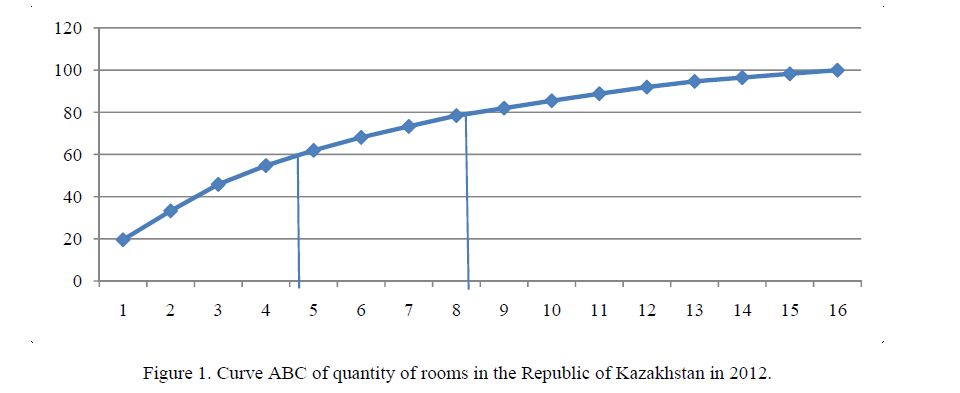
Figure 1. Curve ABC of quantity of rooms in the Republic of Kazakhstan in 2012.
CompiledbytheauthorbasedondatafromtheStatisticsAgencyoftheRepublicofKazakhstan.
Figure 8 illustrates that in the first four of leaders the cities and the areas taking leading positions in ranging are concentrated and make from 50–60 % of number of rooms in Kazakhstan, then from 20–30 % Akmolinskaya, Almaty, Atyrauskaya, Pavlodarskaya and Mangistauskaya areas make. The smallest percentage share is made by the remained areas respectively. Thus, the similar analysis can be made, being based about data of capacity of beds and to the provided quantity of beds in the Republic of Kazakhstan (table 3).
ABC analysis of capacity of beds in the Republic of Kazakhstan in 2012
T a b l e 3
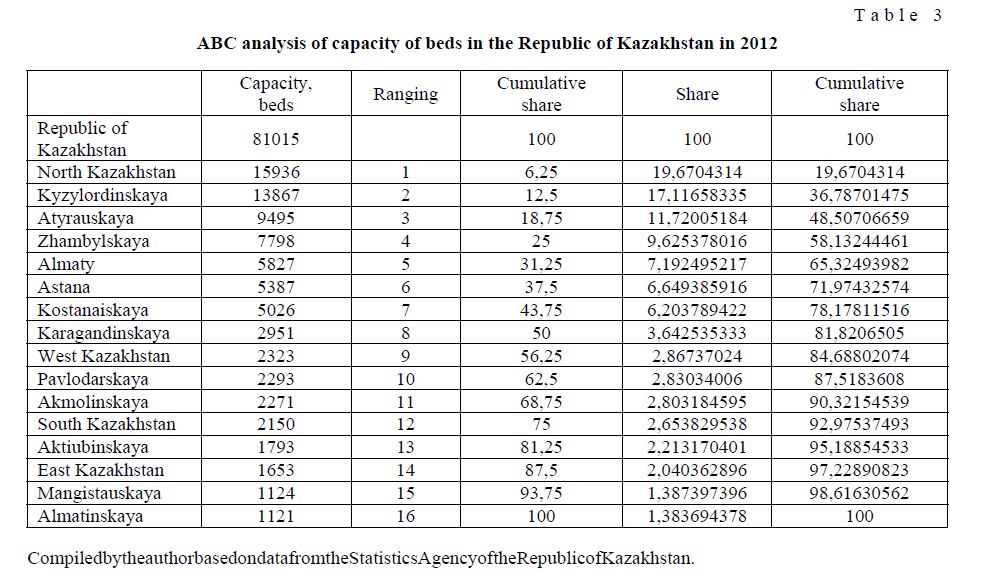
CompiledbytheauthorbasedondatafromtheStatisticsAgencyoftheRepublicofKazakhstan.
On the basis of the presented results of calculations of the ABC analysis in table 3 we constructed curve ABC:
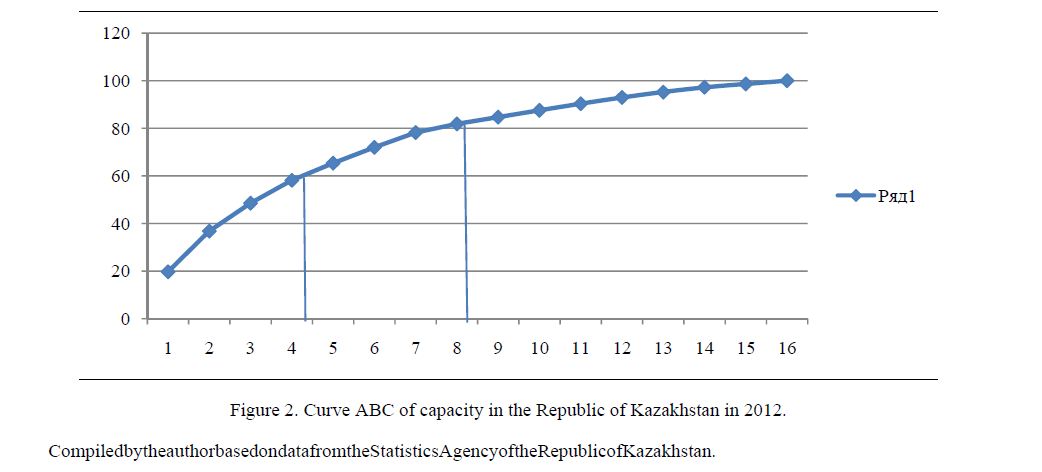
Figure 2. Curve ABC of capacity in the Republic of Kazakhstan in 2012.
CompiledbytheauthorbasedondatafromtheStatisticsAgencyoftheRepublicofKazakhstan.
In this case the first four of leaders includes the North Kazakhstan, Kyzylordinskaya, Atyrauskaya and Zhambylskaya areas in which the capacity of beds of the hotel enterprises makes to 60 % of all share in the country. The following group includes the cities of Almaty and Astana, and also the Kostanaiskaya province. Other areas make the remained share of all capacity of the hotel enterprises in the Republic of Kazakhstan. Let's consider ABC analysis for number of the provided room-night in 2012 (table 4).
ABC analysis of the provided room-night in the Republic of Kazakhstan in 2012
T a b l e 4
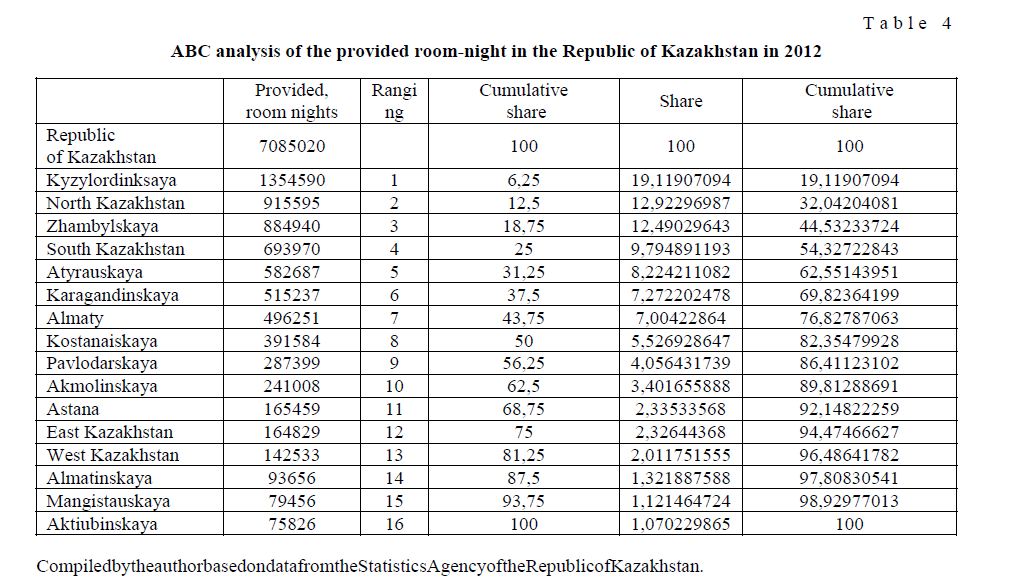
CompiledbytheauthorbasedondatafromtheStatisticsAgencyoftheRepublicofKazakhstan.
Having analysis data, we will construct curve ABC, based on results of a cumulative share of each area and the cities in a total amount (figure 3).

Figure 3. Curve ABC of the provided room-nights in the Republic of Kazakhstan in 2012.
CompiledbytheauthorbasedondatafromtheStatisticsAgencyoftheRepublicofKazakhstan.
The obtained data show that a little more than 60 % of number of the provided room-night in the Republic of Kazakhstan belong to Kyzylordinskaya, North Kazakhstan, Zhambylskaya and South Kazakhstan provinces. The city of Almaty takes the 7th place, Astana the 11th place, the last three of the provided roomnight on the republic is occupied by Almatinskaya, Mangistauskaya and Aktyubinskaya provinces.
From the ABC analysis follows that on the basis of available statistical data of the hotel enterprises, it is possible to carry out classification and ranging of the cities and area according to development of indicators hotel farms in the Republic of Kazakhstan. Thus, areas and the cities having a small contribution among indicators, on the example of «leaders» in this or that category, are able to afford development, and also further introduction of additional plans and strategy, their operational performance according to governmental programs. It should be noted that depending on an indicator, leaders in these categories change also — not always the cities make the most developed from 50 to 60 % of a share in the country. It can speak of a high level of quantity of placements (Almaty, Astana), big movement and mobility as in Kyzylordinskaya, North Kazakhstan and Zhambylskaya provinces. Certainly, regional development as the Republic of Kazakhstan as a whole, and in a section of areas of Astana and Almaty also is a great importance in formation of the hotel industry management. According to data of the World Tourism organization a branch share of the tourism sector in export of the countries entering into the five with the most developed sphere of tourism in the world, reaches 70 %. So, the most visited country is France, then the USA, China, Spain and Italy. Closes ten popular countries of the world Malaysia and Mexico. Today the Republic of Kazakhstan is the member of the World Tourism Organization since 1993, since then in country, the Kazakhstan Tourist Association (KTA) and the Kazakhstan Association of Hotels and Restaurants (KAHR) functions.
References
- Janusz Sarnowski, Edward Kirejczyk. Zarządzanie przedsiębiorstwem turystycznym, WSE, Warszawa,
- The Statistics Agency of the Republic of Kazakhstan: stat.kz
- William M., Dunsmuir, Ralph D., Snyder. ABC Analysis in Inventory Control: The Issue of Stability, Monash University, Department of Econometrics, 1989.